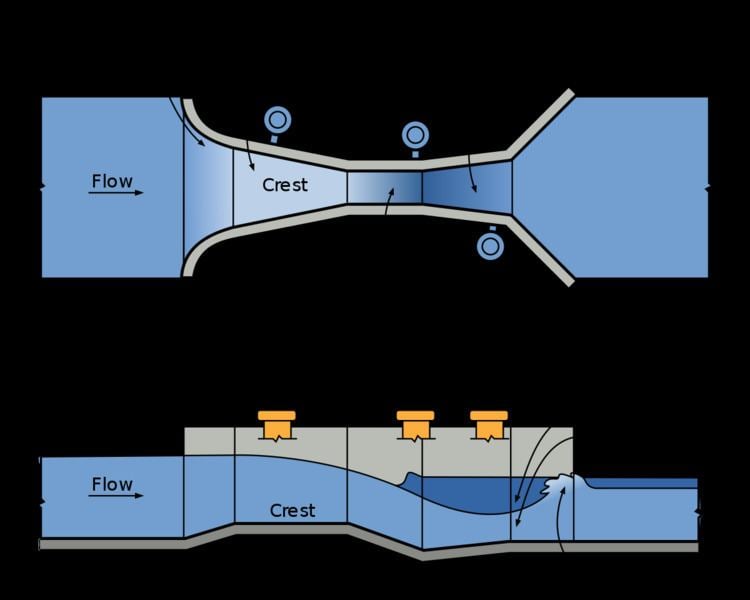 | ||
A venturi flume is a critical-flow open flume with a constricted flow which causes a drop in the hydraulic grade line, creating a critical depth.
Contents
It is used in flow measurement of very large flow rates, usually given in millions of cubic units. A venturi meter would normally measure in millimetres, whereas a venturi flume measures in metres.
Measurement of discharge with venturi flumes requires two measurements, one upstream and one at the throat (narrowest cross-section), if the flow passes in a subcritical state through the flume. If the flumes are designed so as to pass the flow from sub critical to supercritical state while passing through the flume, a single measurement at the throat (which in this case becomes a critical section) is sufficient for computation of discharge. To ensure the occurrence of critical depth at the throat, the flumes are usually designed in such way as to form a hydraulic jump on the downstream side of the structure. These flumes are called 'standing wave flumes'
Comparison with weirs
Venturi flumes have two advantages over weirs where the critical depth is created by a vertical constriction. First, the hydraulic head loss is smaller in flumes than in weirs. Second, there is no dead zone in flumes where sediment and debris can accumulate; such a dead zone exists upstream of the weirs.
Parshall flume
A modified version of the Venturi flume is the Parshall flume. Named after it creator, Dr. Ralph L. Parshall of the U.S. Soil Conservation Service, the Parshall flume is a fixed hydraulic structure used in measuring volumetric flow rate in surface water, wastewater treatment plant, and industrial discharge applications. The Parshall flume accelerates flow though a contraction of both the parallel sidewalls and a drop in the floor at the flume throat. Under free-flow conditions the depth of water at specified location upstream of the flume throat can be converted to a rate of flow.
The free-flow discharge can be summarized as
Where
When the downstream depth is high enough that the transition to subcritical flow advances upstream into the throat and the hydraulic jump disappears, the flume is operating in a "submerged flow" regime, and the discharge is instead given by
Where
The Parshall flume is an empirically calibrated device, so interpolation between listed sizes is not an accurate way to make intermediate size flumes. The flumes are not scale models of each other. 22 standard sizes of Parshall flumes have been developed, covering flow ranges from 0.005 cfs [0.1416 l/s] to 3,280 cfs [92,890 l/s].
Submergence transitions for Parshall flumes range from 50% (1”-3” sizes) to 80% (10’-50’ sizes), beyond which point level measurements must be taken at both the primary and secondary points of measurement and a submergence correction must be applied to the flow equations.
Under laboratory conditions Parshall flumes can be expected to exhibit accuracies to within +/-2%, although field conditions make accuracies better than 5% doubtful.
Not all Parshall flumes have the energy-recovering divergence section. These flumes, called "Montana flumes", or "short-section Parshall flumes", must instead have a free-spilling discharge at all expected flow rates, which increases the drop along the whole flume system. The measurement calculations are the same as for free-flow in a standard Parshall flume, but submerged flow cannot be adjusted for.
Differences between the Venturi and Parshall flume include: reduction of the inlet converging angle, lengthening the throat section, reduction of the discharge divergence angle, and introducing a drop through the throat (and subsequent partial recovery in the discharge section).
Drawbacks
Standards
A venturi flume is similar to the Parshall flume, without the contoured base, but the cross section is usually rectangular, the inlet shorter, and there is a general taper on the outlet similar to the venturi meter. Because of their size, it is usual for these meters to be open to their surroundings just like a river or stream and therefore this type of measurement is referred to as open-channel flow measurement. Parshall flumes are much more efficient than standard flumes and generate a standard wave to effect a measurement.
A good example can be found via google earth: 50°58'41.34"N, 5°51'36.81"E, eye altitude 200 m. This is in the 'Geleenbeek', near Geleen in the Netherlands.
